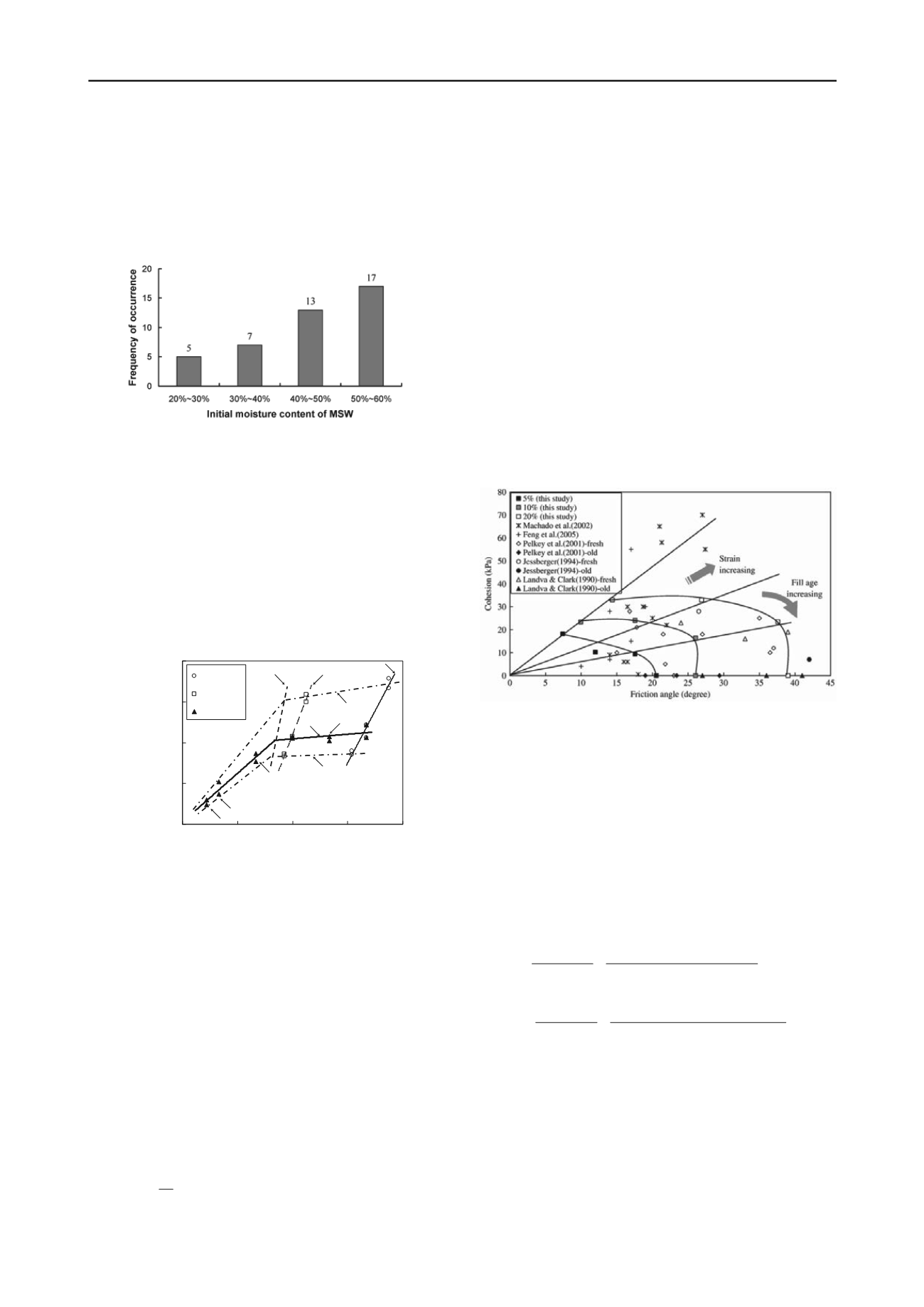
3010
Proceedings of the 18
th
International Conference on Soil Mechanics and Geotechnical Engineering, Paris 2013
corresponding to a matric suction of 10 kPa, and its value for
the Chinese wastes ranges from 33% to 45% (Chen et.al.
2010a), greater than that of the UK waste (22%) and the US
waste (22.4%)(Sharma and Lewis 1994). For decomposed
wastes filled in landfills for a long time, the average value of
field capacity of MSWs in different countries is 37% (Chen
et.al. 2010a).
Figure 1. Initial moisture content of MSWs in China
2.3
Hydraulic conductivity and gas permeability of the MSWs
Results of laboratory tests on borehole samples and in situ
pumping tests of Qizishan landfill, Suzhou, China show that
hydraulic conductivity (
k
s
) of MSW decreases with an increase
in burial depth or overburden pressure due to compaction and
degradation of waste (Chen et al. 2010a). Results of laboratory
tests on the borehole samples also indicate that (see Figure 2)
the gas permeability decreases with an increase in the degree of
saturation (or a decrease in volumetric gas content,
g
), and the
decrease is much more significant at the high range of degree of
saturation (S
r
) (Wei 2007).
1.E-13
1.E-12
1.E-11
1.E-10
1.E-09
0
0.2
0.4
0.6
0.8
Volumetric gas content,
Intrinsic permeability of gas, K
(
m
2
)
S
=
0%
S
=
40%
e=2
I
F
H
P
G
K
S
r
=40%
S
r
=50%
S
r
=60%
S
r
=87%
S
r
=0%
S
r
=20
S
r
=80
e=3
e=1.6
e=2
r
r
θ
g
Figure 2. Gas permeability for MSW sampled from the Qizishan
landfill, China (Wei 2007)
2.4
Compression characteristics of the MSWs
The compression characteristics of MSWs are of greater
complexity than soils, whose solids can be normally regarded as
inert materials. Based on laboratory tests on borehole samples
and artificial wastes, it was found that creep is usually
insignificant compared with the sum of primary and
biodegradation compression for MSWs under favorable
decomposition conditions, and the modified primary
compression index tends to decrease with an increase of waste
depth and age (Chen et al. 2009, 2010b). Laboratory study
showed that MSW with a higher organic content tends to have
larger
C
C
’
(see Eq. 1) and secondary compression potential (Liao
et al. 2007, Xu 2012). A one-dimensional compression model
which considers the coupled effect of stress and age is proposed
to express mechanical compression of MSWs (Chen et al.
2010b):
0
' lg
(1 )
ct
C
tS
C
e
(1)
where
ε
is the total strain corresponding to
σ’
and
t
,
C
C
’
is the
modified primary compression index for fresh wastes,
σ’
(Pa) is
effective stress,
σ
0
’
(Pa) is the initial stress for fresh MSWs,
ε
tS
is ultimate secondary strain which can be calculated as the
ultimate strain under long-term compression minus the primary
compression strain of fresh wastes, and
c
(s
-1
) is the secondary
compression rate constant related to biodegradation process.
2.5
Shear strength characteristics of MSW
Groups of consolidated drained triaxial compression tests were
carried out to investigate the shear strength characteristics of
borehole samples obtained from Qizishan landfill (Zhan et al.
2008). The results showed that the MSW samples exhibited a
strain-hardening and contractive behavior (see Figure 3). As the
fill age of the waste increased from 1.7 years to 11 years, the
cohesion mobilized at a strain level of 10% was found to
decrease from 23.3 kPa to 0 kPa, and the mobilized friction
angle at the same strain level increasing from 9.9° to 26°. For a
confinement stress level greater than 50 kPa, the shear strength
of the recently-placed MSW seemed to be lower than that of the
older MSW. The observed changes of shear strength with the
fill age can be explained by considering the change in the MSW
composition with age (Zhan et al. 2008).
Figure 3. Summary of mobilized shear strength parameters reported in
the research literatures (Zhan et al. 2008)
3 BHM COUPLED MODEL AND CASE STUDY
A Bio-Hydro-Mechanical (BHM) coupled model was proposed
to investigate solid-liquid-gas interaction behaviors in landfilled
MSWs with high organic content (Xu 2011, Chen et al. 2012).
Apart from solid mass loss and gas generation, another key
issue during biodegradation process is the release of celluar
moisture within biodegradable matter, especially for MSWs
high in organic content. Based on first-order kinetics, the source
terms of liquid
f
L,t
(kgm
-3
s
-1
) and gas
f
G,t
(kgm
-3
s
-1
) due to
biodegradation are expressed as:
,
0 0
(
)
(
)
(1 )(
)
i water
c f
t
dSi i water
Sd
L t
S V
S V
m c f
e
dm
f
V V dt
V V
(2)
,
0 0
(1 )
(
)
(1 )
(
)
(1 )(
)
i water
c f
t
dSi i water
Sd
G t
S V
S V
m c f
e
dm
f
V V dt
V V
(3)
where
η
is the reaction coefficient,
m
Sd
(kg) represents solid
mass loss at the time
t
(s),
V
S
and
V
V
(m
3
) are the volumes of solid
matter and void space respectively,
m
dSi
(kg) is the initial mass
of biodegradable component
i
,
c
i
’
(s
-1
) is the decomposition rate
constant of biodegradable component
i
,
V
S0
and
V
V0
(m
3
) are the
initial volumes of solid matter and void space respectively,
ε
is
the compression strain, and
f
water
is the water impact factor.
Mass conservation equations and Darcy’s law for liquid and
gas are used to model fluid flow in landfills (see Eqs. 4 and 5).
Hydraulic conductivity, gas permeability and water retention
characteristics of MSW are estimated based on laboratory
studies as discussed in section 2.2 and 2.3.


